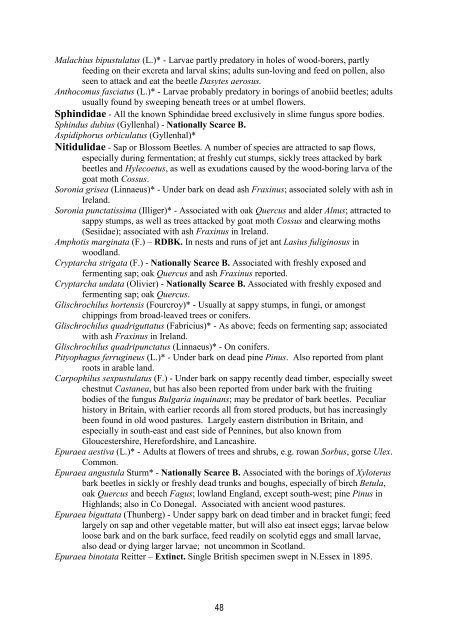Crustacea: Copepoda - Cerambycoidea.com
Crustacea: Copepoda - Cerambycoidea.com
Crustacea: Copepoda - Cerambycoidea.com
Create successful ePaper yourself
Turn your PDF publications into a flip-book with our unique Google optimized e-Paper software.
Malachius bipustulatus (L.)* - Larvae partly predatory in holes of wood-borers, partly<br />
feeding on their excreta and larval skins; adults sun-loving and feed on pollen, also<br />
seen to attack and eat the beetle Dasytes aerosus.<br />
Antho<strong>com</strong>us fasciatus (L.)* - Larvae probably predatory in borings of anobiid beetles; adults<br />
usually found by sweeping beneath trees or at umbel flowers.<br />
Sphindidae - All the known Sphindidae breed exclusively in slime fungus spore bodies.<br />
Sphindus dubius (Gyllenhal) - Nationally Scarce B.<br />
Aspidiphorus orbiculatus (Gyllenhal)*<br />
Nitidulidae - Sap or Blossom Beetles. A number of species are attracted to sap flows,<br />
especially during fermentation; at freshly cut stumps, sickly trees attacked by bark<br />
beetles and Hylecoetus, as well as exudations caused by the wood-boring larva of the<br />
goat moth Cossus.<br />
Soronia grisea (Linnaeus)* - Under bark on dead ash Fraxinus; associated solely with ash in<br />
Ireland.<br />
Soronia punctatissima (Illiger)* - Associated with oak Quercus and alder Alnus; attracted to<br />
sappy stumps, as well as trees attacked by goat moth Cossus and clearwing moths<br />
(Sesiidae); associated with ash Fraxinus in Ireland.<br />
Amphotis marginata (F.) – RDBK. In nests and runs of jet ant Lasius fuliginosus in<br />
woodland.<br />
Cryptarcha strigata (F.) - Nationally Scarce B. Associated with freshly exposed and<br />
fermenting sap; oak Quercus and ash Fraxinus reported.<br />
Cryptarcha undata (Olivier) - Nationally Scarce B. Associated with freshly exposed and<br />
fermenting sap; oak Quercus.<br />
Glischrochilus hortensis (Fourcroy)* - Usually at sappy stumps, in fungi, or amongst<br />
chippings from broad-leaved trees or conifers.<br />
Glischrochilus quadriguttatus (Fabricius)* - As above; feeds on fermenting sap; associated<br />
with ash Fraxinus in Ireland.<br />
Glischrochilus quadripunctatus (Linnaeus)* - On conifers.<br />
Pityophagus ferrugineus (L.)* - Under bark on dead pine Pinus. Also reported from plant<br />
roots in arable land.<br />
Carpophilus sexpustulatus (F.) - Under bark on sappy recently dead timber, especially sweet<br />
chestnut Castanea, but has also been reported from under bark with the fruiting<br />
bodies of the fungus Bulgaria inquinans; may be predator of bark beetles. Peculiar<br />
history in Britain, with earlier records all from stored products, but has increasingly<br />
been found in old wood pastures. Largely eastern distribution in Britain, and<br />
especially in south-east and east side of Pennines, but also known from<br />
Gloucestershire, Herefordshire, and Lancashire.<br />
Epuraea aestiva (L.)* - Adults at flowers of trees and shrubs, e.g. rowan Sorbus, gorse Ulex.<br />
Common.<br />
Epuraea angustula Sturm* - Nationally Scarce B. Associated with the borings of Xyloterus<br />
bark beetles in sickly or freshly dead trunks and boughs, especially of birch Betula,<br />
oak Quercus and beech Fagus; lowland England, except south-west; pine Pinus in<br />
Highlands; also in Co Donegal. Associated with ancient wood pastures.<br />
Epuraea biguttata (Thunberg) - Under sappy bark on dead timber and in bracket fungi; feed<br />
largely on sap and other vegetable matter, but will also eat insect eggs; larvae below<br />
loose bark and on the bark surface, feed readily on scolytid eggs and small larvae,<br />
also dead or dying larger larvae; not un<strong>com</strong>mon in Scotland.<br />
Epuraea binotata Reitter – Extinct. Single British specimen swept in N.Essex in 1895.<br />
48

















